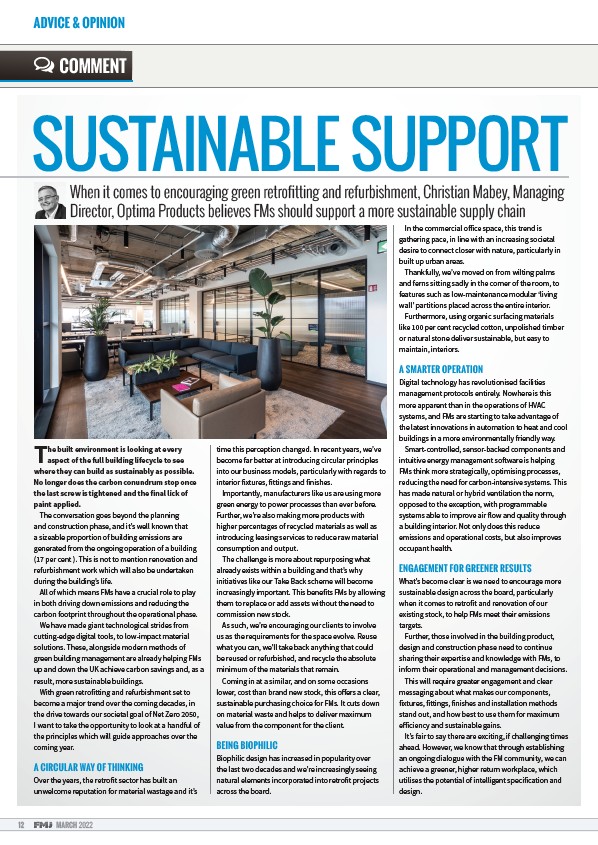
COMMENT
SUSTAINABLE SUPPORT
When it comes to encouraging green retrofi tting and refurbishment, Christian Mabey, Managing
Director, Optima Products believes )Ms should support a more sustainable supply chain
The built environment is looking at every
aspect of the full building lifecycle to see
where they can build as sustainably as possible.
No longer does the carbon conundrum stop once
the last screw is tightened and the final lick of
paint applied.
The conversation goes beyond the planning
and construction phase, and it’s well known that
a sizeable proportion of building emissions are
generated from the ongoing operation of a building
(17 per cent ). This is not to mention renovation and
refurbishment work which will also be undertaken
during the building’s life.
All of which means FMs have a crucial role to play
in both driving down emissions and reducing the
carbon footprint throughout the operational phase.
We have made giant technological strides from
cutting-edge digital tools, to low-impact material
solutions. These, alongside modern methods of
green building management are already helping FMs
up and down the UK achieve carbon savings and, as a
result, more sustainable buildings.
With green retrofitting and refurbishment set to
become a major trend over the coming decades, in
the drive towards our societal goal of Net Zero 2050,
I want to take the opportunity to look at a handful of
the principles which will guide approaches over the
coming year.
A CIRCULAR WAY OF THINKING
Over the years, the retrofit sector has built an
unwelcome reputation for material wastage and it’s
12 MARCH 2022
time this perception changed. In recent years, we’ve
become far better at introducing circular principles
into our business models, particularly with regards to
interior fixtures, fittings and finishes.
Importantly, manufacturers like us are using more
green energy to power processes than ever before.
Further, we’re also making more products with
higher percentages of recycled materials as well as
introducing leasing services to reduce raw material
consumption and output.
The challenge is more about repurposing what
already exists within a building and that’s why
initiatives like our Take Back scheme will become
increasingly important. This benefits FMs by allowing
them to replace or add assets without the need to
commission new stock.
As such, we’re encouraging our clients to involve
us as the requirements for the space evolve. Reuse
what you can, we’ll take back anything that could
be reused or refurbished, and recycle the absolute
minimum of the materials that remain.
Coming in at a similar, and on some occasions
lower, cost than brand new stock, this oœ ers a clear,
sustainable purchasing choice for FMs. It cuts down
on material waste and helps to deliver maximum
value from the component for the client.
BEING BIOPHILIC
Biophilic design has increased in popularity over
the last two decades and we’re increasingly seeing
natural elements incorporated into retrofit projects
across the board.
In the commercial oœ ice space, this trend is
gathering pace, in line with an increasing societal
desire to connect closer with nature, particularly in
built up urban areas.
Thankfully, we’ve moved on from wilting palms
and ferns sitting sadly in the corner of the room, to
features such as low-maintenance modular ‘living
wall’ partitions placed across the entire interior.
Furthermore, using organic surfacing materials
like 100 per cent recycled cotton, unpolished timber
or natural stone deliver sustainable, but easy to
maintain, interiors.
A SMARTER OPERATION
Digital technology has revolutionised facilities
management protocols entirely. Nowhere is this
more apparent than in the operations of HVAC
systems, and FMs are starting to take advantage of
the latest innovations in automation to heat and cool
buildings in a more environmentally friendly way.
Smart-controlled, sensor-backed components and
intuitive energy management soª ware is helping
FMs think more strategically, optimising processes,
reducing the need for carbon-intensive systems. This
has made natural or hybrid ventilation the norm,
opposed to the exception, with programmable
systems able to improve air flow and quality through
a building interior. Not only does this reduce
emissions and operational costs, but also improves
occupant health.
ENGAGEMENT FOR GREENER RESULTS
What’s become clear is we need to encourage more
sustainable design across the board, particularly
when it comes to retrofit and renovation of our
existing stock, to help FMs meet their emissions
targets.
Further, those involved in the building product,
design and construction phase need to continue
sharing their expertise and knowledge with FMs, to
inform their operational and management decisions.
This will require greater engagement and clear
messaging about what makes our components,
fixtures, fittings, finishes and installation methods
stand out, and how best to use them for maximum
eœ iciency and sustainable gains.
It’s fair to say there are exciting, if challenging times
ahead. However, we know that through establishing
an ongoing dialogue with the FM community, we can
achieve a greener, higher return workplace, which
utilises the potential of intelligent specification and
design.
ADVICE & OPINION